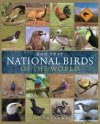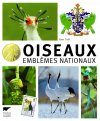About this book
Birds are one of the most popular and visible forms of all wildlife and are inextricably linked with the development of human cultures all around the world. Over the years some of the most eye-catching species of bird have been officially or unofficially adopted by countries as symbols of their national identity; there are now almost 100 national birds spanning every imaginable group from condors to parrots, trogons to frigatebirds.
Both a comprehensive listing and guide book, National Birds of the World provides a range of information from species data to how these birds have been used and abused through the ages. It recounts tales of how they came to be adopted and presents a wide range of official and cultural contexts where they appear from feathers in tribal costumes to stamps and currency.
Contents
Introduction
- Angola, Peregrine Falcon
- Anguilla, Zenaida Dove
- Antigua and Barbuda, Magnificent Frigatebird
- Argentina, Rufous Hornero
- Australia, Emu Dromaius
- Austria, Barn Swallow
- Bahamas, Caribbean Flamingo
- Bahrain, White-cheeked Bulbul
- Bangladesh, Oriental Magpie Robin
- Belarus, White stork
- Belgium, Common Kestrel
- Belize, Keel-billed Toucan
- Bermuda, Bermuda Petrel (cahow)
- Bhutan, Common Raven
- Bolivia, Andean Condor
- Botswana, Lilac-breasted Roller, Golden Eagle
- Brazil, Rufous-bellied Thrush
- British Virgin Islands, Mourning Dove
- Burma, Burmese Peacock-Pheasant
- Cambodia, Giant Ibis
- Cayman Islands, Caribbean Amazon
- Chile, Andean Condor
- China, Red-crowned Crane
- Colombia, Andean Condor
- Costa Rica, Clay-coloured Thrush
- Cote D'Ivoire, White-cheeked Turaco
- Cuba, Cuban Trogon
- Denmark, Mute Swan
- Dominica, Imperial Amazon
- Dominican Republic, Palmchat
- Ecuador, Andean Condor
- El Salvador Turquoise-browed Motmot
- Estonia, Barn Swallow
- Faroe Islands, Eurasian Oystercatcher
- Finland, Whooper Swan
- France, Gallic Rooster (Red Jungle Fowl)
- Germany, White-tailed Eagle
- Gibraltar, Barbary Partridge
- Greece, Little Owl
- Grenada, Grenada Dove
- Guatemala, Resplendent Quetzal
- Guyana, Hoatzin
- Haiti, Hispaniolan Trogon
- Honduras, Scarlet Macaw
- Hungary, Great Bustard
- Iceland, Gyrfalcon
- India, Indian Peafowl
- Indonesia, Javan Hawk-eagle
- Iraq, Chukar Partridge
- Israel, Hoopoe
- Ireland, Winter Wren, European Robin
- Jamaica, Red-billed Streamertail
- Japan, Green Pheasant
- Jordan, Sinai Rosefinch
- Latvia, White Wagtail (Balt Cielava)
- Liberia, Common Bulbul
- Lithuania, White Stork
- Luxembourg, Goldcrest
- Malawi, Bar-tailed Trogon
- Mauritius, Dodo
- Me Xico, Crested Caracara, Golden Eagle
- Montserrat, Montserrat Oriole
- Namibia, Crimson-breasted Shrike
- Nepal, Himalayan Monal
- New Zealand, North Island Brown Kiwi
- Nicaragua, Turquoise-browed Motmot
- Nigeria, Black Crowned Crane
- Norway, White-throated Dipper
- Pakistan, Chukar Partridge
- Palestinian Territories, Palestine Sunbird (Proposed)
- Panama, Harpy Eagle
- Papua New Guinea, Raggiana Bird-of-paradise
- Paraguay, Bare-throated Bellbird
- Peru, Andean Cock-of-the-rock
- Philippines, Philippine Eagle
- Puerto Rico, Puerto Rican Spindalis
- Romania, Great White Pelican
- Saint Helena, Saint Helena Plover
- Saint Kitts and Nevis, Brown Pelican
- Saint Vincent and the Grenadines, St Vincent Parrot
- Scotland, Golden Eagle
- Singapore, Crimson Sunbird
- South Africa, Blue Crane
- South Korea, Magpie
- South Sudan, African Fish Eagle
- Spain Spanish, Imperial Eagle
- Sri Lanka, Sri Lanka Junglefowl
- Sudan, Secretary-bird
- Swaziland, Purple-crested Turaco
- Sweden, Common Blackbird
- Thailand, Siamese Fireback
- Trinidad and Tobago, Scarlet Ibis, Cocrico
- Turkey, Redwing
- Uganda, Grey Crowned-crane
- United Kingdom, European Robin
- United States, Bald Eagle
- Venezuela, Troupial
- Zambia, African Fish Eagle
- Zimbabwe, African Fish Eagle
References
Glossary
Index
Customer Reviews (1)
-
99 national birds
By
Keith
4 Feb 2016
Written for Hardback
There are 196 countries around the world, and almost half of them have chosen a “national bird” at some point. This book takes 99 of these countries and reveals the bird selected by each nation. The text describes the bird, its lifestyle, how it was chosen – and importantly, where to see it. The latter aspect is fine for birds like the African Fish Eagle Haliaeetus vocifer which was chosen by Malawi, Namibia, Zambia and Zimbabwe. However the national bird of Belgium and France is the “Gallic Rooster” – or Red Junglefowl Gallus gallus, and you’d mostly likely see one of those strung up in a butcher’s shop!
Each species is richly illustrated with photos, including shots of the ephemera that indicate the selection – such as coins, stamps and national flags. Some choices are blindingly obvious such as the Emu Dromaius novaehollandiae for Australia and Kiwi Apteryx sp. for New Zealand. But there are odd examples in amongst the choices. Liberia did not choose the Liberian Greenbul Phyllastrephus leucolepis (a species that was both found and lost in 1985), but instead decided on the Common Bulbul Pycnonotus barbatus – a bird that most birders would choose to forget!
Actually I do think that national birds should be for the enjoyment of the nation’s people, so it is best to select a bird that they know already. Burma was brave in choosing the Grey Peacock-pheasant Polyplectron bicalcaratum – a bird that many of us would like to see if only it would reveal itself! Although you still have more chances to see that than the Dodo Raphus cucullatus – the national bird of Mauritius, which was last seen in 1662.
This book will be interesting for a wide audience as it focuses not just on the birds, but their cultural presence both today and in history. There is also a section of emblem miscellany with little-known facts about the national birds and those others that are featured in the country’s historical documents but was never awarded the title of “national bird”.
Was this helpful to you? Yes No
Biography
Ron Toft is a freelance wildlife journalist and photographer. He is editor of the It's A Wild World nature pages on TheTravelEditor.com travel website. He travels the world in search of imagery and writes for magazines all over the world including Travel Zambia, Good Motoring, The Countryman, Veterinary Times and for numerous airline and ferry titles. He is a weekly contributor on aviculture or ornithology to Cage & Aviary Birds.









































